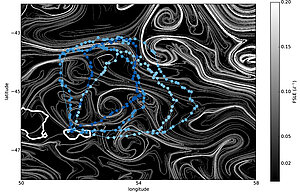Elephant seals and macaroni penguins follow threads
Image of the Month - July 2016
An elephant seal track overlaid on FSLE. Color scale shows left the "Quasi-Planktonicity Index" (QPI), which identifies the degree of similarity of animal trajectories to drifters ones (low values meaning the animal is like a drifter, high that it is moving on its own). Each dot corresponds to a daily GPS observation. Right, the attempt capture rates measured through accelerometry (the seal is moving faster when trying to capture a prey). Note that the colorscales are reversed to better highlight that lower QPI correspond to higher attempt capture rates. In most cases locations with low QPI correspond to high capture rate.
(Credits LOcean/ CEBC)

Phytoplankton are not fixed in space, contrary to terrestrial vegetation. Together with zooplankton, these organisms are transported and redistributed by the currents, and their patterns can vary on scales of several tens of kilometers in the course of a few days. Marine predators such as penguins, pelagic (i.e. open ocean) fishes and marine mammals have to find their preys in this dynamical landscape, which changes on temporal scales that overlap with the ones of animals' foraging trips.
Nevertheless, the ocean transport does not behave randomly: fluid dynamical features like fronts and eddies constitute the skeleton that structures the ocean upper layer in regions with different physical, biogeochemical and ecological properties (such as temperature, quantity and quality of phytoplankton, etc). This fluid dynamical skeleton and its effect on anything that is drifting can be estimated by analyses of altimetry, which provides ocean currents and their temporal evolution down to the 10-100 km, weeks to months scale. In turn, the dynamical landscape which marine predators explore can be studied.
Recent studies have shown that fronts and eddies can drive the trajectories of larger animals such as elephant seals and penguins when they are foraging. Fast swimming organisms where thought to head to these features and to explore them actively. However, a study that combined bio-logging data of Southern elephant seals and altimetry observation has now revealed that, when foraging more intensively, predators are also entrained by oceanic currents. This "quasi-planktonic" behaviour can be understood by imagining that a predator that found a profitable region will concentrate its swimming effort on diving, remaining in the same water parcel, and therefore drifting with it. This behavior has been observed on the ridges of Finite Size Lyapunov Exponents (FSLE), an index used to identify transport fronts and eddy peripheries, suggesting that those features are rich in preys.
These results suggest that is possible to estimate the position of foraging regions for top predators using transport-based diagnostics that can be calculated from altimetry. This approach can be a complementary tool to prioritize regions of the ocean that are particularly important from an ecological viewpoint and help the decision making for the design of Marine Protected Areas in the open ocean. Developing satellite-based methods for identifying physical features of ecological relevance is indeed an urgent need for conservation ecology, in view of the ongoing effort of extending natural reserves from the territorial waters far into the open ocean.
See also:
- Data: Finite-Size Lyapunov Exponent
- Applications: Mesoscale circulation
- Applications: Biology
Other web sites on this subject:
- Argonautica CNES educational project with penguins and elephant seals'tracking vs physical oceanography environmental maps.
- CEBC
References:
- Della Penna, Alice, Silvia De Monte, Elodie Kestenare, Christophe Guinet, and Francesco d’Ovidio. "Quasi-planktonic behavior of foraging top marine predators." Scientific reports 5 (2015).
- Bon, Cecile, Alice Della Penna, Francesco d’Ovidio, John YP Arnould, Timothée Poupart, and Charles-André Bost. "Influence of oceanographic structures on foraging strategies: Macaroni penguins at Crozet Islands." Movement ecology 3, no. 1 (2015): 1.
- Della Penna, Alice, Philippe Koubbi, Cedric Cotté, Cecile Bon, Charles-André Bost and Francesco d’Ovidio, "Lagrangian analysis of multi-satellite data in support of open ocean Marine Protected Area design", Deep Sea Research II, in revision


















